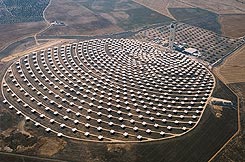
Despite growing economic uncertainty over the last year, three major clean-energy sectors — solar photovoltaics (PV), wind power, and biofuels — kept up a blistering growth rate, increasing 53 percent from $75.8 billion in 2007 to $115.9 billion in revenues in 2008, according to the Clean Energy Trends 2009 report released today by Clean Edge, Inc. By 2018, Clean Edge forecasts that these three sectors will have revenues of $325.1 billion.
During the conference call discussion of the report, Joel Makower, one of the report’s authors acknowledged that a 2009 shakeout will happen. He observed, “2009 will not be a happy year for start-ups.” A number of renewable energy and biofuel plants and projects have been delayed or cancelled due to lack of project financing. OptiSolar to First Solar for $400 million shows that major players are eager to acquire technology leaders faced with this credit crisis.
In spite of short-term challenges, Clean Edge forecasts strong growth over the mid- to long-term. Their past reports have forecasted growth and been correct.
Global production and wholesale pricing of biofuels reached $34.8 billion in 2008 and are projected to total $105.4 billion by 2018. Last year, the global biofuels market consisted of more than 19 billion gallons of ethanol and biodiesel production worldwide. In Brazil, ethanol from sugarcane surpassed petroleum use for the first time.
Wind power became the first clean-energy sector to surpass the $50 billion mark. Its $51.4 billion in worldwide revenue in 2008 is expected to grow to $139.1 billion in 2018. Last year’s global wind power installations reached a record 27,000 MW, including more than 8,000 MW in the U.S., pushing the U.S. ahead of Germany as the world’s leading generator of wind energy.
Solar PV (including modules, system components, and installation) totaled $29.6 billion last year and will reach $80.6 billion globally by 2018. Annual solar PV installations reached more than 4 GW worldwide in 2008, a fourfold increase from four years earlier, when the solar PV market reached the gigawatt milestone for the first time.
For the first time, the report examines the “green jobs dividend.” Solar PV and wind power provided more than 600,000 direct and indirect jobs globally in 2008 and are expected to generate 2.7 million jobs by 2018.
Clean Energy Trends 2009 also outlines five trends poised to make an impact on the markets in the coming year. It describes:
• What happens when the smart grid goes online
• How energy storage will become a key issue for utilities
• Where new clean-energy markets are emerging around the world
• Why grid transmission capacity will be making headlines in 2009
• The unseen growth in “micropower” grids
Smart grids often include smart charging of electric vehicles. Some smart grid trails, such as Boulder, Colorado, include vehicle-to-grid (V2G) pilot projects. During the conference call, report co-author Clint Wilder answered a question by stating that active utility investment in smart charging was not predicted until there are many more electric vehicles on the road – there is about 40,000 EVs in use in the United States. Joel Makower observed that innovators such as Coulomb Technologies and Better Place are active in the build-out of a charging infrastructure. Gridpoint’s acquisition of V2Green was also identified as boost for smart grid and smart charging. Gridpoint has raised over $220 million to date.
“The clean-energy sector, like the broader economy, faces many challenges,” said Clean Edge co-founder and managing director Ron Pernick. “But while 2009 will be a difficult year, we believe that clean energy will play a central role in any global economic recovery.”
Free download is available for the Clean Energy Trends report (20+ pages).
